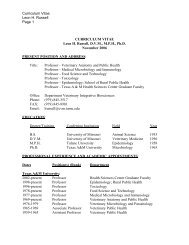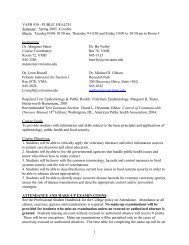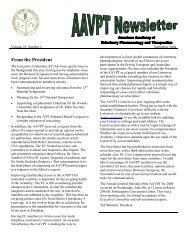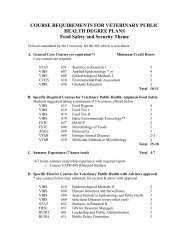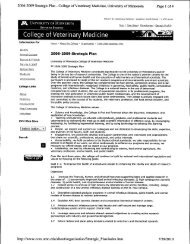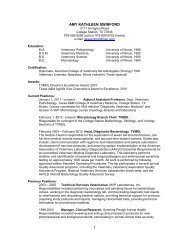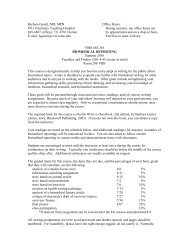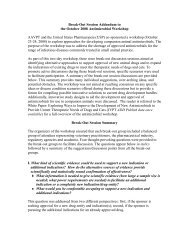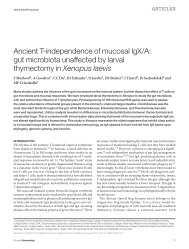FLUOROQUINOLONES (Veterinary—Systemic) - College of ...
FLUOROQUINOLONES (Veterinary—Systemic) - College of ...
FLUOROQUINOLONES (Veterinary—Systemic) - College of ...
Create successful ePaper yourself
Turn your PDF publications into a flip-book with our unique Google optimized e-Paper software.
For empiric treatment <strong>of</strong> probable Pseudomonas aeruginosa<br />
or Staphylococcus infections in dogs, the higher end <strong>of</strong> the<br />
dosage range may be preferable, pending susceptibility<br />
results.<br />
Strength(s) usually available:<br />
U.S.— {R-96}<br />
Veterinary-labeled product(s):<br />
11.4 mg (Rx) [Dicural Tablets].<br />
45.4 mg (Rx) [Dicural Tablets].<br />
136 mg (Rx) [Dicural Tablets].<br />
Canada— {R-99}<br />
Veterinary-labeled product(s):<br />
11.4 mg (Rx) [Dicural Tablets].<br />
45.4 mg (Rx) [Dicural Tablets].<br />
136 mg (Rx) [Dicural Tablets].<br />
Packaging and storage: Store below 40 ºC (104 ºF), preferably<br />
between 15 and 30 ºC (59 and 86 ºF), unless otherwise specified<br />
by manufacturer.<br />
USP requirements: Not in USP. {R-105}<br />
ENROFLOXACIN<br />
Summary <strong>of</strong> Differences<br />
Pharmacology/pharmacokinetics: Biotransformation—Enr<strong>of</strong>loxacin is<br />
de-ethylated to form cipr<strong>of</strong>loxacin; therapeutic concentrations <strong>of</strong><br />
cipr<strong>of</strong>loxacin can be reached with dosing calculated to achieve<br />
effective enr<strong>of</strong>loxacin concentrations.<br />
Side/adverse effects: Cats—Retinal degeneration (acute blindness,<br />
mydriasis) has been reported with enr<strong>of</strong>loxacin at doses higher<br />
than 5 mg per kg <strong>of</strong> body weight a day.<br />
Oral Dosage Forms<br />
Note: The text between ELUS and EL describes uses not included in U.S.<br />
product labeling. Text between ELCAN and EL describes uses that are<br />
not included in Canadian product labeling.<br />
The ELUS or ELCAN designation can signify a lack <strong>of</strong> product<br />
availability in the country indicated. See also the Strength(s)<br />
usually available section for each dosage form.<br />
ENROFLOXACIN TABLETS<br />
Usual dose: Bacterial infections—<br />
Cats: Oral, 5 mg per kg <strong>of</strong> body weight a day. {R-1} The dose may<br />
be administered as a single daily dose or divided into two<br />
equal doses administered every twelve hours. {R-1}<br />
Note: The above dose recommendation is based on risk <strong>of</strong><br />
retinal damage in cats administered doses higher than 5<br />
mg/kg. {R-1}<br />
Dogs: Oral, 5 to 20 mg per kg <strong>of</strong> body weight a day. {R-1} The dose<br />
may be administered as a single daily dose or divided into two<br />
equal doses administered every twelve hours. {R-1}<br />
Note: For empiric treatment <strong>of</strong> probable Pseudomonas<br />
aeruginosa or Staphylococcus infections in dogs, the<br />
higher end <strong>of</strong> the dosage range may be preferable,<br />
pending susceptibility results.<br />
Note: ELUS,CAN<br />
Bustards—Although the safety and efficacy have not<br />
been established, an oral dose <strong>of</strong> 10 mg per kg <strong>of</strong> body weight<br />
every twelve hours has been suggested for the treatment <strong>of</strong><br />
susceptible bacterial infections, based on pharmacokinetic<br />
data. EL{R-41}<br />
Cats—Although the efficacy has not been established, if<br />
enr<strong>of</strong>loxacin is used in the treatment <strong>of</strong> ELUS,CAN<br />
Bartonella<br />
henselaeEL infection or ELUS,CAN EL hemobartonellosis in cats, the<br />
USP Veterinary Medicine Committee currently recommends the<br />
administration <strong>of</strong> 5 mg per kg <strong>of</strong> body weight a day. Limited<br />
research studies on the treatment <strong>of</strong> these infections have<br />
sometimes led to recommendations for higher dosages;<br />
{R-72; 148}<br />
however, there is concern about the occurrence <strong>of</strong> retinal<br />
degeneration with doses higher than those recommended on<br />
product labeling.<br />
Dogs— ELUS,CAN<br />
An oral dose <strong>of</strong> 3 mg per kg <strong>of</strong> body weight every<br />
twelve hours for seven days has been used in the treatment <strong>of</strong><br />
Rocky Mountain spotted fever in dogs, based on a controlled<br />
therapeutic trial using disease models. EL{R-84}<br />
ELUS,CAN<br />
Ducks, pet or research—In the U.S., extra-label use is<br />
banned in ducks: Although the safety and efficacy have not been<br />
established, an oral dose <strong>of</strong> 10 mg per kg <strong>of</strong> body weight a day<br />
has been suggested for the treatment <strong>of</strong> susceptible bacterial<br />
infections in Muscovy ducks, based on pharmacokinetic<br />
data. EL{R-42}<br />
ELUS,CAN<br />
Foals—Although the safety and efficacy have not been<br />
established, an oral dose <strong>of</strong> 2.5 mg per kg <strong>of</strong> body weight once a<br />
day for eight days has been recommended in the treatment <strong>of</strong><br />
susceptible bacterial infections in foals. Because <strong>of</strong> the potential<br />
for arthropathy in immature animals, use is recommended in<br />
foals only when other antimicrobials are inappropriate. EL{R-85}<br />
ELUS,CAN<br />
Horses—In the U.S., for use only in animals not to be<br />
used for food production—Although the safety and efficacy<br />
have not been established, an oral dose <strong>of</strong> 7.5 to 10 mg per kg <strong>of</strong><br />
body weight every twenty-four hours has been recommended. {R-<br />
24-27; 93}<br />
Tablets have been crushed and suspended in water for<br />
administration {R-27} or ground into a powder and mixed in sugar<br />
syrup. EL{R-25}<br />
ELUS,CAN<br />
Pacu, red—Although the safety and efficacy have not<br />
been established, administration <strong>of</strong> enr<strong>of</strong>loxacin by immersion<br />
<strong>of</strong> fish in a bath <strong>of</strong> a 2.5 mg per liter solution <strong>of</strong> enr<strong>of</strong>loxacin for<br />
five hours, every twenty-four to forty-eight hours, has been<br />
suggested for the treatment <strong>of</strong> susceptible bacterial infections in<br />
red pacu fish, based on pharmacokinetic data. EL{R-44}<br />
ELUS,CAN Parrots, African grey—Although the safety and efficacy<br />
have not been established, an oral dose <strong>of</strong> 7.5 to 30 mg per kg <strong>of</strong><br />
body weight every twelve hours has been suggested in the<br />
treatment <strong>of</strong> susceptible bacterial infections in African grey<br />
parrots, based on pharmacokinetic data. {R-39} The risk <strong>of</strong> side<br />
effects increases with higher doses; polyuria and polydipsia have<br />
been reported with the dose <strong>of</strong> 30 mg per kg <strong>of</strong> body weight. EL{R-<br />
39}<br />
ELUS,CAN Rabbits, pet or research—In the U.S., extra-label use is<br />
banned in rabbits: Although the safety and efficacy have not<br />
been established, an oral dose <strong>of</strong> 5 mg per kg <strong>of</strong> body weight<br />
every twelve hours for fourteen days has been recommended in<br />
the treatment <strong>of</strong> pasteurellosis in rabbits, based on clinical<br />
efficacy studies. EL{R-67-69}<br />
Strength(s) usually available:<br />
U.S.— {R-1}<br />
Veterinary-labeled product(s):<br />
22.7 mg (Rx) [Baytril Tablets (film-coated); Baytril Taste<br />
Tabs].<br />
68 mg (Rx) [Baytril Tablets (film-coated); Baytril Taste<br />
Tabs].<br />
136 mg (Rx) [Baytril Taste Tabs].<br />
Canada— {R-102}<br />
Veterinary-labeled product(s):<br />
15 mg (Rx) [Baytril Tablets].<br />
50 mg (Rx) [Baytril Tablets].<br />
150 mg (Rx) [Baytril Tablets].<br />
Packaging and storage: Store below 40 ºC (104 ºF), preferably<br />
between 15 and 30 ºC (59 and 86 ºF), unless otherwise specified<br />
by the manufacturer. Store in a tight container.<br />
© 2007 The United States Pharmacopeial Convention All rights reserved 13




